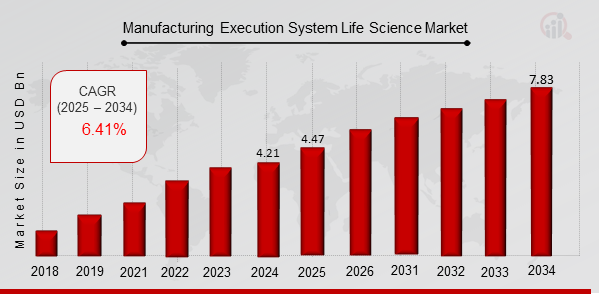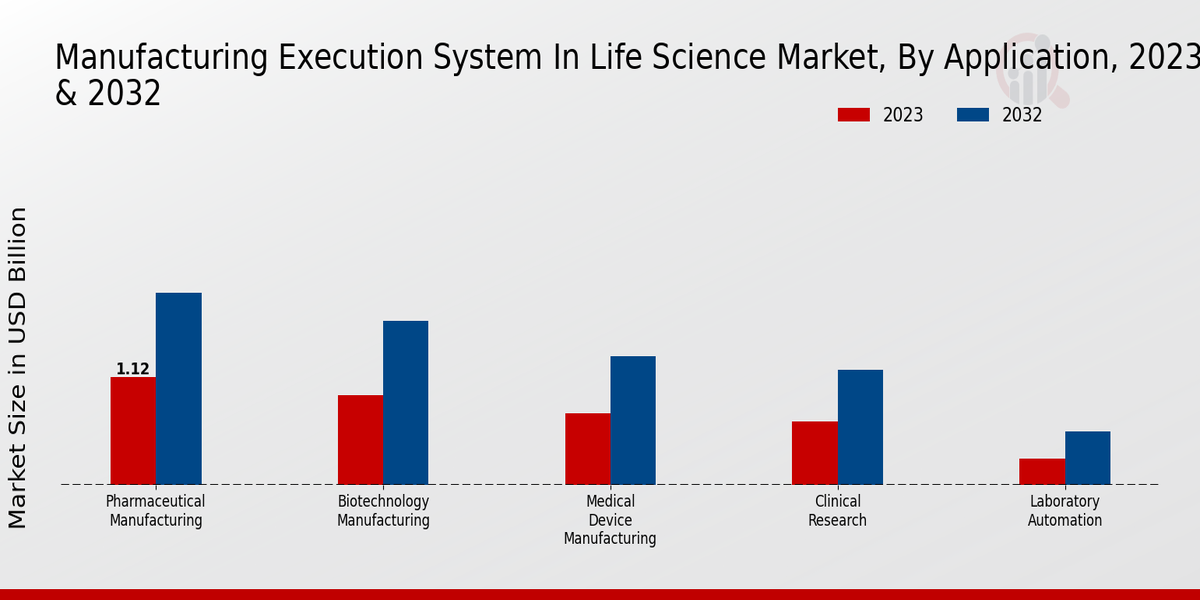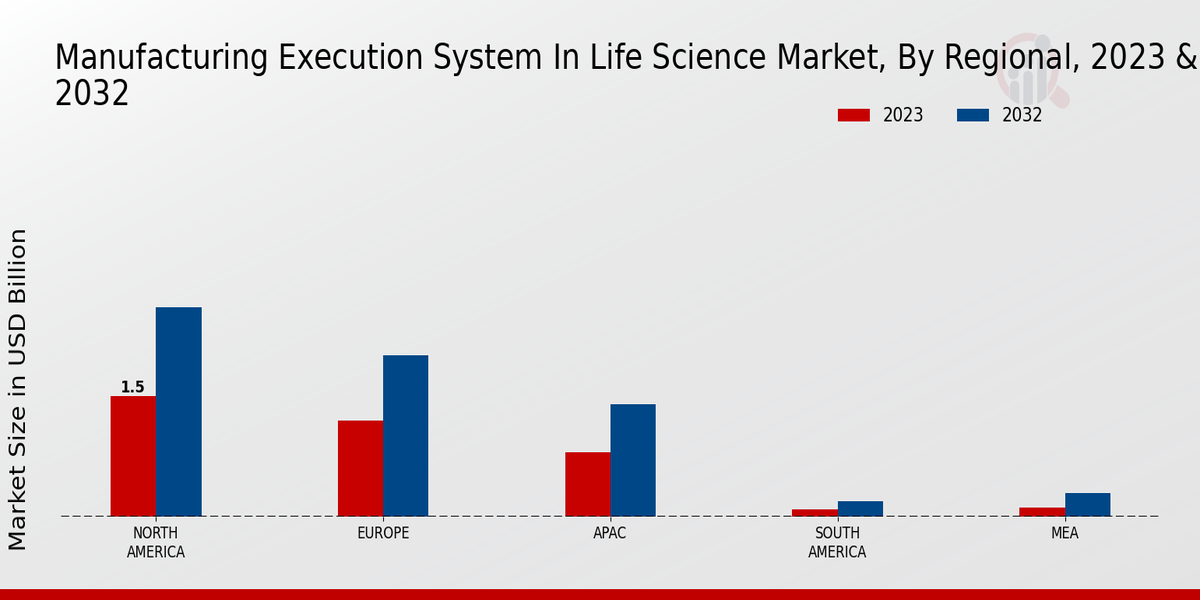Manufacturing Execution System in Life Science Market Overview
As per MRFR analysis, the Manufacturing Execution System Life Science Market Size was estimated at 4.21 (USD Billion) in 2024. The Manufacturing Execution System Life Science Market Industry is expected to grow from 4.47 (USD Billion) in 2025 to 7.83 (USD Billion) till 2034, at a CAGR (growth rate) is expected to be around 6.41% during the forecast period (2025 - 2034).
Key Manufacturing Execution System in Life Science Market Trends Highlighted
The Manufacturing Execution System in Life Science Market is witnessing several significant trends. With the increasing emphasis on regulatory compliance and the need for efficient production processes, the adoption of manufacturing execution systems (MES) is more crucial than ever. Key market drivers include the rising demand for real-time monitoring and data integration, which support improved operational efficiency and product quality within the life sciences sector. These systems offer transparency and help companies meet stringent regulatory requirements, thereby making them essential tools for manufacturing in pharmaceuticals and biotechnology.
Opportunities in this market continue to expand, particularly as organizations seek to streamline their operations and enhance their production capabilities. The integration of advanced technologies such as artificial intelligence and the Internet of Things provides a pathway for companies to achieve more agile and responsive manufacturing processes. As life sciences firms focus on personalized medicine and complex product development, MES solutions that support flexibility and adaptability will be critical to meeting these new demands.
Recent times have seen a shift toward cloud-based MES solutions, which offer scalability and reduced operational costs.This trend reflects a broader industry move toward digital transformation, allowing life sciences companies to leverage advanced analytics and machine learning for better decision-making. Furthermore, the focus on sustainability has prompted manufacturers to adopt MES solutions that enable resource optimization, waste reduction, and energy efficiency, aligning operational practices with global sustainability goals. Overall, the landscape is evolving rapidly, marked by technological advancements and a continuous push for efficiency and compliance amid growing market demands.

Source: Primary Research, Secondary Research, Market Research Future Database and Analyst Review
Manufacturing Execution System in Life Science Market Drivers
Growing Need for Real-Time Monitoring and Analytics
The Manufacturing Execution System in Life Science Market Industry is experiencing a significant shift towards real-time monitoring and analytics. As companies strive to enhance operational efficiency and ensure compliance with stringent regulatory requirements, there is an increasing demand for systems that provide real-time visibility into production processes. This demand is driven by the need to maintain product quality, minimize waste, and optimize resources.With the complexity of life sciences manufacturing, where even minor deviations can lead to significant financial losses and regulatory penalties, the necessity for real-time data becomes paramount.
Manufacturing Execution Systems (MES) are key enablers of these capabilities, allowing organizations to track performance metrics, identify bottlenecks, and make data-driven decisions on the fly. This ability to gather and analyze data instantly helps in reducing cycle times, improving output quality, and enhancing overall productivity, which is essential for maintaining a competitive edge in the Manufacturing Execution System in the Life Science Market Industry.
Increase in Regulatory Compliance and Quality Standards
The ongoing rise in regulatory requirements and quality standards in the life sciences sector is another crucial driver for the Manufacturing Execution System in the Life Science Market Industry. Pharma and biotech companies are under constant pressure to adhere to stringent regulations enforced by government agencies. Manufacturing Execution Systems help in automating compliance processes, documenting data accurately, and ensuring that the production meets required standards.By streamlining compliance efforts, these systems reduce the risk of violations that could lead to penalties or recalls, thus fostering a more reliable manufacturing environment.
Adoption of Industry 4.0 and Digital Transformation
As the life sciences sector undergoes a technological revolution, the adoption of Industry 4.0 principles is driving growth in the Manufacturing Execution System in the Life Science Market Industry. The integration of advanced technologies such as IoT, AI, and big data analytics in manufacturing processes enables life sciences companies to operate more efficiently and cost-effectively. Digital transformation initiatives are embracing MES solutions that facilitate automation, connectivity, and intelligence across the production landscape, leading to smarter manufacturing environments.
Manufacturing Execution System in Life Science Market Segment Insights
Manufacturing Execution System in Life Science Market Application Insights
The Manufacturing Execution System in the Life Science Market under the Application segment is witnessing a pronounced increase in value, poised to reach significant numbers by 2032. In 2023, the market's overall valuation stood at 3.72 USD Billion, showing a steady upward trajectory fueled by the growing demand for efficient manufacturing processes and strict regulatory compliance in the life sciences sector. The market segmentation reveals key areas that are driving this growth. Pharmaceutical Manufacturing commands a notable position, valued at 1.12 USD Billion in 2023, and is projected to grow to 2.0 USD Billion by 2032.
This sub-segment holds a majority share of the market due to the increasing need for enhanced visibility and control over production processes, ensuring product quality and compliance with regulatory standards.
Biotechnology Manufacturing follows closely, with a valuation of 0.93 USD Billion in 2023, expected to increase to 1.71 USD Billion in 2032. This area is gaining traction as biotechnology companies seek integrated solutions to optimize operational efficiency, which is crucial for the fast-paced nature of biopharmaceutical product development. Medical Device contract Manufacturing also plays a significant role, valued at 0.74 USD Billion in 2023 and projected to rise to 1.34 USD Billion by 2032, as manufacturers focus on improving production efficiency and adhering to safety regulations, thereby ensuring patient safety and effective product delivery.
Moreover, Clinical Research, valued at 0.66 USD Billion in 2023, with expectations of growing to 1.2 USD Billion by 2032, is crucial for accelerating drug development processes and regulatory approval, highlighting the necessity for robust data management solutions. Lastly, Laboratory Automation, though smaller in scale at 0.27 USD Billion in 2023, is anticipated to grow to 0.55 USD Billion in 2032, driven by the increasing adoption of automation technologies in laboratories, which facilitate better workflow efficiency and consistency in research outcomes.
Each of these areas contributes to the overall growth of the Manufacturing Execution System in the Life Science Market, emphasizing the importance of segmentation in understanding market dynamics, trends, and opportunities in the evolving life sciences landscape.

Source: Primary Research, Secondary Research, Market Research Future Database and Analyst Review
Manufacturing Execution System in Life Science Market Deployment Type Insights
The Manufacturing Execution System in the Life Science Market is segmented by Deployment Type, which includes On-Premise, Cloud-Based, and Hybrid solutions. As of 2023, the overall market value has reached 3.72 USD Billion, highlighting a robust interest in deployment strategies. Organizations are increasingly gravitating towards Cloud-Based solutions due to enhanced scalability, flexibility, and reduced IT overhead, making them a significant contributor to market growth. On-premise systems still dominate due to stringent regulatory requirements in the life sciences sector, as they provide greater control over critical processes and data security.
Meanwhile, Hybrid solutions, which combine both On-Premise and Cloud-Based technologies, are becoming popular, as they offer a balance of flexibility and compliance, catering to diverse organizational needs. The market is also experiencing a rise in investments focused on digital transformation, enhancing operational efficiencies, and ensuring regulatory compliance, driving the demand further.
The combination of these deployment types fosters a competitive landscape, paving the way for innovation and efficiency in the Manufacturing Execution System in the Life Science Market industry.Overall, the Manufacturing Execution System in Life Science Market segmentation paints a promising picture for growth, supported by evolving technological advancements and an increasing emphasis on compliance.
Manufacturing Execution System in Life Science Market Functionality Insights
The Manufacturing Execution System in the Life Science Market focuses significantly on the Functionality segment, which is expected to play a vital role in enhancing operational efficiency and regulatory compliance within the industry. In 2023, the market exhibited a valuation of USD 3.72 billion, reflecting a steady increase in demand for advanced systems. Among the functionalities, Production Tracking is essential as it ensures real-time monitoring of production processes, aiding in efficiency improvement. Quality Management stands out as a critical component, given the stringent regulatory landscape in life sciences that prioritizes product quality and safety.
Laboratory Management facilitates the optimal use of laboratory resources, while Compliance Management helps organizations adhere to industry standards and regulations. Additionally, Inventory Management becomes increasingly significant as it manages and optimizes stock levels to prevent shortages and overstock scenarios. The market is driven by advancements in technology, the need for improved operational effectiveness, and increasing regulatory requirements, which create both challenges and opportunities for companies operating in this space.Emerging trends suggest a growing integration of artificial intelligence and machine learning within these functionalities, contributing to the overall enhancement of the Manufacturing Execution System in Life Science Market revenue.
Manufacturing Execution System in Life Science Market End User Insights
The Manufacturing Execution System in the Life Science Market, valued at 3.72 billion USD in 2023, reveals a interesting landscape in the End User segment, comprising Pharmaceutical Companies, Biotech Companies, Contract Manufacturing Organizations, and Research Institutions. Pharmaceutical Companies play a crucial role, typically leveraging advanced manufacturing execution systems to enhance compliance and production efficiency. Biotech Companies increasingly adopt these systems to streamline their complex operational processes, ensuring rapid innovation and responsiveness to regulatory changes.
Contract Manufacturing Organizations are significant in this market, often dominating due to their pivotal role in providing essential outsourcing solutions for pharmaceutical production, thus driving demand for efficient execution systems. Research Institutions also contribute meaningfully, seeking advanced technologies to support their investigations and development processes.
The combined dynamics of these varied end-users reflect the growing need for efficient, compliant manufacturing processes tailored to the life sciences, with the overall market anticipated to grow, driven by technological advancements and increasing regulatory pressures, alongside the rising need for cost reduction and operational efficiency.Market trends indicate that a focus on automation and real-time data analytics will further influence the Manufacturing Execution System in Life Science Market revenue and its ongoing development.
Manufacturing Execution System in Life Science Market Regional Insights
The Manufacturing Execution System in the Life Science Market, valued at 3.72 USD Billion in 2023, is poised for steady growth across various regions. North America holds a majority share with a valuation of 1.5 USD Billion in 2023, expected to grow to 2.6 USD Billion by 2032, emphasizing its significant role in the industry due to robust pharmaceutical and biotechnology sectors. Europe follows with a market size of 1.2 USD Billion in 2023, anticipated to reach 2.0 USD Billion in 2032, highlighting its importance in compliance-driven manufacturing processes.
The APAC region, while valued at 0.8 USD Billion in 2023, forecasts an increase to 1.4 USD Billion, driven by rapid industrialization and increasing healthcare demands. In contrast, South America and MEA account for smaller market shares, valued at 0.1 USD Billion and 0.12 USD Billion in 2023, but they are gradually emerging as potential growth areas. Overall, the Manufacturing Execution System in Life Science Market segmentation reveals that North America and Europe continue to dominate, reflecting their established manufacturing ecosystems and investment in technology.

Source: Primary Research, Secondary Research, Market Research Future Database and Analyst Review
Manufacturing Execution System in Life Science Market Key Players and Competitive Insights
The Manufacturing Execution System in Life Science Market is characterized by its complexity and critical importance in ensuring compliance and enhancing operational efficiency within the pharmaceutical and biotechnology industries. As these sectors continue to grow and evolve, driven by increasing regulatory requirements and technological advancements, the competitive landscape has become increasingly intricate. Key players in this market provide various solutions that connect production processes, track data in real-time, and facilitate decision-making, ensuring that manufacturing operations are conducted in a compliant, efficient, and cost-effective manner.
A close look at the competitive dynamics reveals a rich ecosystem of companies striving to leverage innovative technologies such as cloud computing, IoT, and advanced analytics, all aimed at optimizing production and ensuring the safety and reliability of life-saving products.Optel Group has established a significant presence in the Manufacturing Execution System in Life Science Market, where its strengths lie in offering comprehensive tracking and tracing solutions that enhance the visibility of production processes.
The company specializes in developing high-level software solutions aimed at ensuring compliance with regulatory standards and improving overall operational efficiency in manufacturing. With a focus on integrating advanced technology, Optel Group empowers clients to gain better control over production lines, thereby reducing the risk of errors and waste while enhancing product quality.
Cisco Systems has carved a niche for itself in the Manufacturing Execution System in the Life Science Market by leveraging its robust networking and communication technologies. The company's strengths lie in its ability to provide secure, scalable, and reliable systems that facilitate seamless data exchange and connectivity across manufacturing processes. By enhancing connectivity and data transparency in manufacturing environments, Cisco Systems plays a crucial role in helping life science companies navigate the complex regulatory landscape and maintain high standards of product quality and safety.
Key Companies in the Manufacturing Execution System in the Life Science Market Include
Manufacturing Execution System in Life Science Market Industry Developments
In the Manufacturing Execution System in Life Science Market, recent developments include a significant rise in the adoption of digital technologies and automation solutions aimed at boosting manufacturing efficiencies. Companies like Optel Group and Emerson are focusing on providing systems that enhance product traceability and compliance with regulatory standards, while Zebra Technologies is expanding its portfolio to include advanced data management solutions. Current affairs reveal that GE Digital and Siemens are actively enhancing their MES offerings to meet the growing demand for integrated systems in biopharmaceutical production.
Notably, Honeywell's recent collaboration with Abbott Laboratories aims to develop solutions that streamline manufacturing processes amidst increasing regulatory scrutiny. Furthermore, some mergers have recently occurred, with SAP and Rockwell Automation aligning their technologies to improve operational efficiency across the life sciences sector. The market valuation for these companies is experiencing upward trends due to heightened investments in R&D, reflecting positive growth prospects and a competitive landscape that continues to evolve rapidly. As the focus on compliance and efficiency increases, these market shifts are significantly impacting operational strategies within the life sciences manufacturing sector.
Manufacturing Execution System in Life Science Market Segmentation Insights
Manufacturing Execution System in Life Science Market Application Outlook
- Pharmaceutical Manufacturing
- Biotechnology Manufacturing
- Medical Device Manufacturing
Manufacturing Execution System in Life Science Market Deployment Type Outlook
Manufacturing Execution System in Life Science Market Functionality Outlook
Manufacturing Execution System in Life Science Market End User Outlook
- Contract Manufacturing Organizations
Manufacturing Execution System in Life Science Market Regional Outlook
| Report Attribute/Metric |
Details |
|
Market Size 2024
|
4.21 (USD Billion)
|
|
Market Size 2025
|
4.47 (USD Billion)
|
|
Market Size 2034
|
7.83 (USD Billion)
|
|
Compound Annual Growth Rate (CAGR)
|
6.41 % (2025 - 2034)
|
|
Report Coverage
|
Revenue Forecast, Competitive Landscape, Growth Factors, and Trends
|
|
Base Year
|
2024
|
|
Market Forecast Period
|
2025 - 2034
|
|
Historical Data
|
2020 - 2024
|
| Market Forecast Units |
USD Billion |
| Key Companies Profiled |
Optel Group, Cisco Systems, Zebra Technologies, Abbott Laboratories, SAP, Honeywell, Emerson, GE Digital, Illumina, AMRI, Schneider Electric, Dassault Systemes, Siemens, Rockwell Automation, Plexus |
| Segments Covered |
Application, Deployment Type, Functionality, End User, Regional |
| Key Market Opportunities |
Cloud-based solutions adoption, Regulatory compliance optimization, Integration with IoT technologies, Real-time data analytics enhancement, Increasing demand for process automation |
| Key Market Dynamics |
Regulatory compliance requirements, Increasing automation adoption, Demand for real-time data, Need for enhanced traceability, Focus on operational efficiency. |
| Countries Covered |
North America, Europe, APAC, South America, MEA |
Frequently Asked Questions (FAQ):
The expected market size in 2034 is valued at 7.83 USD Billion.
The anticipated CAGR for the market from 2025 to 2034 is 6.41%.
North America is expected to have the largest market share with a valuation of 2.6 USD Billion in 2032.
The market value for Pharmaceutical Manufacturing in 2032 is projected to be 2.0 USD Billion.
Major players in the market include Optel Group, Cisco Systems, Zebra Technologies, Abbott Laboratories, SAP, and Honeywell.
The market size for Biotechnology Manufacturing in 2023 is valued at 0.93 USD Billion.
The expected growth rate for Laboratory Automation from 2024 to 2032 indicates significant development in the market.
The MEA region is valued at 0.12 USD Billion in the Global Manufacturing Execution System in the Life Science Market for the year 2023.
The Clinical Research segment is projected to have a value of 1.2 USD Billion in 2032.
The forecasted market value for Medical Device Manufacturing in 2032 is 1.34 USD Billion.

















